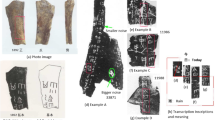Abstract
Calligraphy occupies a distinguished position in Chinese traditional culture. For long-term preservation, many calligraphy works have been carved on stones or woods in the form of relief. In this paper, we present a novel solution that enables fast modeling of Chinese calligraphy relief from 2D handwriting image, which benefits from the advances of deep learning. We first construct a relief dataset composed of diverse types of calligraphy fonts and then design a convolutional neural network for height predictions. Through the trained network, one can quickly generate homogeneous type, inhomogeneous type or hybrid style of reliefs. The advantage over previous methods is that our method does not require parameter tuning and is fast in generating calligraphy reliefs from different resolution of inputs. A number of experiments and comparisons prove the effectiveness of our method.













Similar content being viewed by others
References
Zhang, T., Zhang, L., Yu, J.: Computer generation of 3D inscriptions from 2D images of Chinese calligraphy. Jisuanji Xuebao/Chin. J. Comput. 37(11), 2380–2388 (2014)
Zhang, Y.W., Chen, Y., Liu, H., Ji, Z., Zhang, C.: Modeling Chinese calligraphy reliefs from one image. Comput. Graph. 70(2), 300–306 (2018)
Zhang, Y.W., Wu, J., Ji, Z., Wei, M., Zhang, C.: Computer-assisted relief modelling: a comprehensive survey. Comput. Graph. Forum 38(2), 521–534 (2019)
Kolomenkin, M., Leifman, G., Tal, A. Shimshoni, I.: Reconstruction of relief objects from line drawings. In: IEEE Conference on Computer Vision and Pattern Recognition, pp. 993–1000. IEEE (2011)
Li, Z., Wang, S., Yu, J., Ma, K.L.: Restoration of brick and stone relief from single rubbing images. IEEE Trans. Vis. Comput. Graph. 18(2), 177–187 (2012)
Zeng, Q., Martin, R.R., Wu, L., Auinn, J.A., Sun, Y., Tu, C.: Region-based bas-relief generation from a single image. Graph. Models 76(3), 140–151 (2013)
Furferi, R., Governi, L., Volpe, Y., Puggelli, L., Vanni, N., Carfagni, M.: From 2D to 2.5D i.e. from painting to tactile model. Graph. Models 76(6), 706–723 (2014)
Sykora, D., Kavan, L., Jacobson, A., Whited, B., Simmons, M.: Ink-and-Ray: bas-relief meshes for adding global illumination effects to hand-drawn characters. ACM Trans. Graph. 33(2), 16 (2014)
Hudon, M., Grogan, M., Pages, R., Smolic, A.: Deep normal estimation for automatic shading of hand-drawn characters. In: European Conference on Computer Vision, pp. 246–262 (2018)
Su, W., Du, D., Yang, X., Zhou, S., Fu, H.: Interactive sketch-based normal map generation with deep neural networks. In: Proceedings of ACM SIGGRAPH Symposium on Interactive 3D Graphics and Games, vol. 1, pp. 1–17. ACM (2018)
Jian, M., Dong, J., Gong, M., Yu, H., Nie, L., Yin, Y., Lam, K.-M.: Learning the traditional art of Chinese calligraphy via three-dimensional reconstruction and assessment. IEEE Trans. Multimed. 99, 1–1 (2019)
Ronneberger, O., Fischer, P., Brox, T.: U-Net: convolutional networks for biomedicalimage segmentation. In: International Conference on Medical Image Computing and Computer-Assisted Intervention, pp. 234–241 (2015)
Chollet, F.: Keras. https://github.com/fchollet/keras (2015)
Kingma, D.P., Ba, J.: Adam: a method for stochastic optimization. In: CoRR, arXiv:1412.6980 (2014)
JDSoft ArtForm: https://us.jingdiao.com/product-technology/software/jdsoft-artform (2015)
Yang, H., Zhang, Z., Guan, Y.: Rolling bilateral filter-based text image deblurring. Vis. Comput. 35, 1627–1640 (2019)
Du, H., Jin, X., Willis, P.J.: Two-level joint local laplacian texture filtering. Vis. Comput. 32, 1537–1548 (2016)
Wang, Y., Wang, H., Cao, J.: A contour self-compensated network for salient object detection. Vis. Comput. 36, 1–13 (2020)
Acknowledgements
The authors would like to thank the anonymous reviewers for their careful reviews and valuable suggestions. This work was supported in part by the National Natural Science Foundation of China (No. 61772293), and the NSFC-Zhejiang Joint Fund of the Integration of Informatization and Industrialization (U1609218).
Author information
Authors and Affiliations
Corresponding author
Ethics declarations
Conflict of interest
The authors certify that there is no conflict of interest with any organization for the present work.
Additional information
Publisher's Note
Springer Nature remains neutral with regard to jurisdictional claims in published maps and institutional affiliations.
Rights and permissions
About this article
Cite this article
Zhang, YW., Wang, J., Long, W. et al. A fast solution for Chinese calligraphy relief modeling from 2D handwriting image. Vis Comput 36, 2241–2250 (2020). https://doi.org/10.1007/s00371-020-01917-2
Published:
Issue Date:
DOI: https://doi.org/10.1007/s00371-020-01917-2




